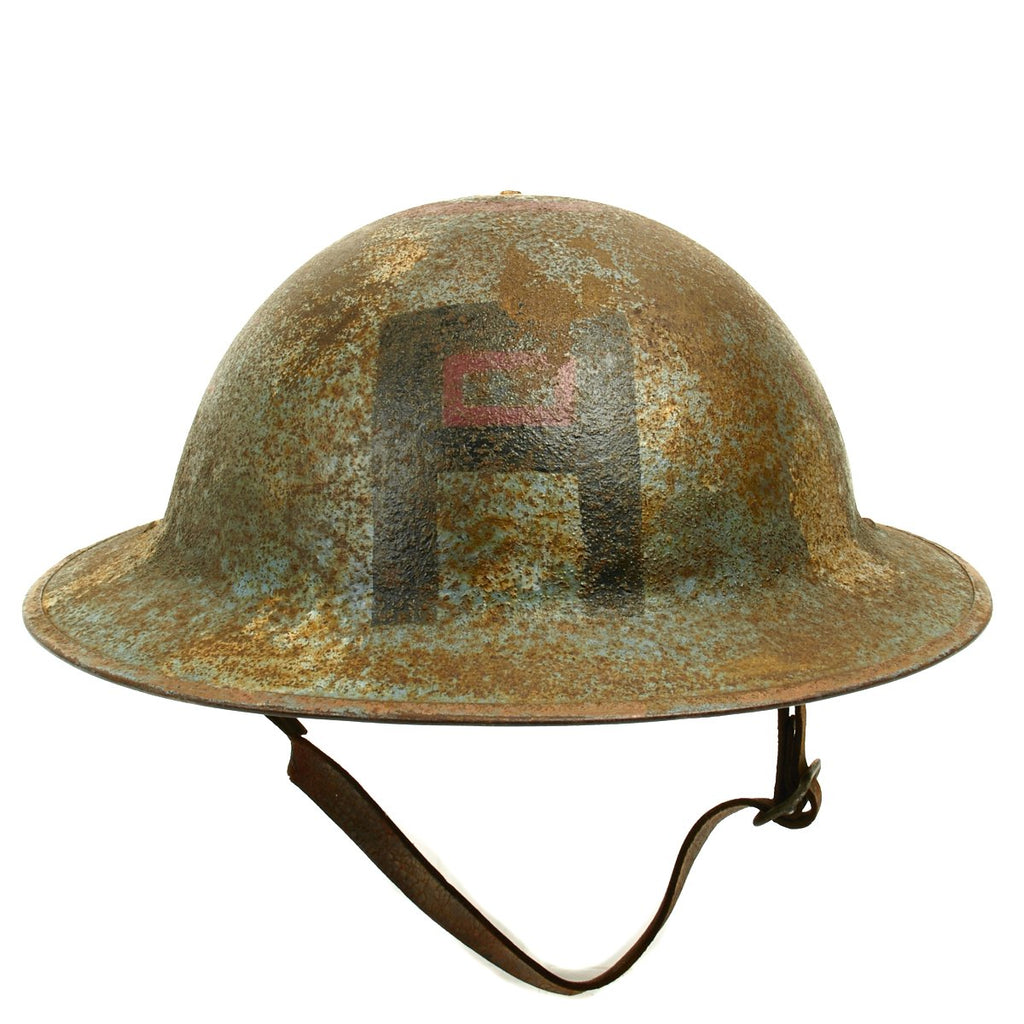-
Original Item: Only One Available. This is an incredibly rare WWI helmet that features totally original period paint. The shell is maker marked with a stamping on the underside of the rim that reads ZC 200. This is a wonderful example of a genuine Aero squadron Great War helmet from the Air Service of the American Expeditionary Force. Features original hand painted pilot wings, biplane, First Army Air Service insignia, and the U.S. aircraft cockade, or roundel, of late World War I on the crown. Included are a original liner and chinstrap.
In 1917, upon the United States' entry into World War I, the first major U.S. aviation combat force was created when an Air Service was formed as part of the American Expeditionary Force (AEF). Major General Mason Patrick commanded the Air Service of the AEF; his deputy was Brigadier General Billy Mitchell. These aviation units, some of which were trained in France, provided tactical support for the U.S. Army, especially during the Battle of Saint-Mihiel and the Meuse-Argonne offensives. Among the aces of the AEF Air Service were Captain Eddie Rickenbacker and 2nd Lieutenant Frank Luke. Concurrent with the creation of this combat force, the U.S. Army's aviation establishment in the United States was removed from control of the Signal Corps and placed directly under the United States Secretary of War. An assistant secretary was created to direct the Army Air Service, which had dual responsibilities for development and procurement of aircraft, and raising and training of air units. With the end of the First World War, the AEF's Air Service was dissolved and the Army Air Service in the United States largely demobilized.
The history of the First Army Air Service dates to the first American Air Service personnel arriving in France. On 15 January 1918, Colonel William Mitchell was appointed Chief of the Air Service, I Corps, First Army. At this time, the I Corps was being formed for the purpose of administratively handling all of the American troops then on the Western Front. Headquarters was located at Neufchâteau, France. When the first American Aero Squadrons arrived at the front in April 1918, they were assigned to the quiet Toul Sector. At this time, the American Air Service on the front consisted of only a few Aero Squadrons of the 1st Pursuit Group.
At the end of June, 1918, Air Service, I Corps moved from the Toul Sector to the Château-Thierry Sector as part of I Corps. The I Corps Observation Group was already in the Chateau-Thierry Sector was under the command of First Army. The Assistant Chief of Air Service, Zone of Advance, felt it was necessary to coordinate the observation groups of First Army with the pursuit groups. On 10 August 1918, the First American Army Air Service was established.
The unit was formally organized on 26 August at Ligny-en-Barrois, France It consisted of the French Aerial Division, which consisted of a large number of pursuit and day bombardment squadrons. In addition, there was one other French pursuit group and three American pursuit groups-one American day-bombardment group-the 1st Army observation, and one French Army artillery group for the adjustment of long-range artillery fire. Eight night-bombardment squadrons of the British Royal Air Force. were to cooperate with the First Army Air Service whenever the tactical situation made such action expedient. The establishment of the First Army Air Service marked the first contingent of American air forces under its own commander.
The front of the First Army, extending from Châtillon-sous-les-Côtes to Pont-sur-Seille, insofar as aviation was concerned, had been very quiet for some time. The enemy performed his photographic reconnaissances with single aircraft, flying at high altitudes, and his pursuit patrols were small and infrequent. In the matter of airdromes, the enemy was better off than the First American Army, and possessed many small fields within access of any part of the front line. Several airdromes were unoccupied, and were in such condition that they could be utilized quickly by reinforcements, their barracks and hangars being more or less serviceable.
For the Americans, almost every available field had been taken up and they were short in hangars and billet space, so that by the time the allocation of aviation units had been made to the First Army, the problems of locating and housing the units was a serious one.
The M1917 was the US Army's first modern combat helmet, used from 1917 and during the 1920s, before being replaced by the M1917A1. The M1917A1 helmet was an updated version of the M1917 and initially used refurbished WW1 shells.
The M1917 is a near identical version of the British Mk.I steel helmet, and it is important to note that when the US joined the Great War in 1917 they were initially issued with a supply of around 400,000 British made Mk.Is, before production began state side. The M1917 differed slightly in its lining detail, and exhibited US manufacture markings.
M1917 helmet liners typically show a paper label at the crown and the dome rivet head. The liner is set up as on the British versions, with an oilcloth band and net configuration, attached to a leather strap, riveted to the shell. The chinstrap is leather with steel buckle.
- This product is available for international shipping.
- Eligible for all payments - Visa, Mastercard, Discover, AMEX, Paypal & Sezzle


We Buy Military Antiques
Our team expert buyers travels the world to pay fair prices for entire estate collections to singular items.
START SELLING TODAY




















